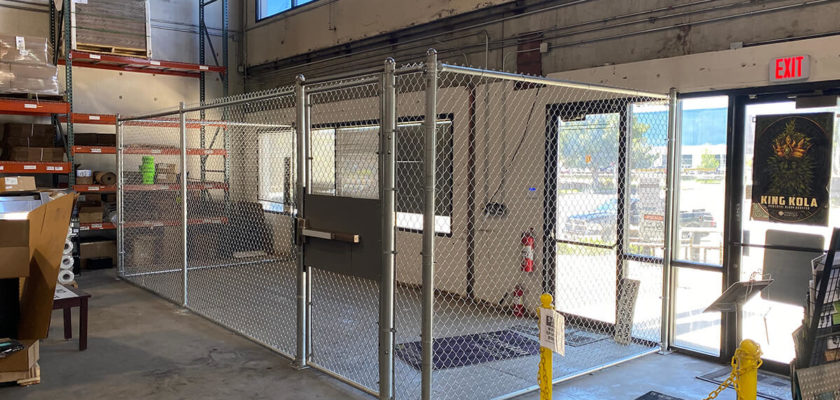Curious to learn more about the different parts of a fence? Should you plan to build a fence on your property in the near future, understanding its components eases frustrations and ensures you get the perfect fence installed correctly the first time around. It is vital that homeowners take time to learn more about the components of a fence before investing their hard-earned money into the project. Although many styles of fences can add flair and functionality to a property, wooden and chain link fences remain the most popular choices. In this guide, we’ll learn more about the components needed to build these two fence styles.
Components of a Wood Fence

The following components come together to create a beautiful wooden fence on your property. Most homeowners build the wood fence around the backyard of the home, although some install them around the entirety of the property. In both scenarios, you’ll need the following parts.
Picket/Baluster
Wooden fences have either pickets or a baluster that sometimes are spaced up against one another to create a privacy fence. Pickets come in assorted sizes, but the most common is 5/8″. Balusters usually use 2x lumber for added strength and durability.
Post
The post holds the fence up. It is secured into the ground, most often using concrete, so that the fence holds in place and does not fall over. Most fence posts use 4×4 lumber, though its height and size affect the post material. Should a fence post fail to hold up, the fence is a goner.
Top Rail
The top rail secures balusters. It is attached to the fence posts. Without the top rail, you will not have a fence!
Bottom Rail
The bottom rail serves the same function as the top rail except it’s placed in a different location.
Base
The base supports the posts of the fence into the ground. The cement base gives the fence added strength.
Hinges
Hinges allow the components of the fence to hold it together. Most fences require two hinges but taller or heavier fences may require three hinges.
Latch
The latch attached to a fence allows them to swing open and shut securely. Most homeowners add a lock to the latch for added security and protection, though it isn’t necessary.
The above components are needed to build a wooden fence, whether you choose a standard fence or a privacy fence. Without these components, your fence will fail quickly after it is built.
Add-On Fence Components

In addition to the components listed above, there are additional optional components that can add functionality, style, and design to a wood fence. Among the components of a fence you can add on as an option:
Post Toppers
Post toppers and caps attach to the top of the wood fence post. They’re sold at home improvement stores, online, and of course, from Denco, and give fences a simple and unique style that draws curb appeal.
Gates and entryways
Gates give fences added security and homeowners more protection. You can purchase pre-built gates or build your own from scratch. They’ll provide access to and from the front yard as well as an exit from the backyard. Getting a gate that blends perfectly with your newly built fence is fairly simple.
Trim Board
Trim boards create a more flattering, finished look. The board is placed around the face of the fence.
Kick Board
A kick board is a 2×6 or 2×8 horizontal piece of wood that runs along the fence base. The kick board serves as added protection for the pickets, protecting them against mud and rainwater. The kick board also gives the fence a more finished appeal.
Cap Board
A cap board is also 2×6 or 2×8 slabs of wood that runs along the top of the pickets and post. It “caps” off the top of the fence. It is not right for every fence but an option considered by many people. To install a cap board, all pickets and posts must be cut to the same height.
There are additional components of a fence we did not cover here. For a more inclusive list or to request a free estimate, give Denco a call without delay. Our Denver fence experts are ready to assist you in every way we possibly can.
Parts of a Chain Link Fence

Homeowners choose chain link fences when they seek an affordable, practical fencing option. Chain link fences lack aesthetic appeal but certainly work well to conceal areas and provide added security and protection. The following parts of a fence complete the chain link fence style.
Chain Link (Mesh):
Chain link serves the same purpose as balusters on a wooden fence: it creates a barrier that stops people from entering a specific area. Chain link is also called mesh. It is made from coated steel so it is strong and durable. Chain link material can also withstand severe weather.
Fence Tie
The fence tie secures each chain link section to the posts.
Top Rail, End Rails, Bottom Rails
A chain link fence is secured with a top rail, end rails, and bottom rails. The rails secure the wire to the post.
Wire
Wire interlocks the mesh together on the fence. Wire comes in assorted sizes to accommodate different types of chain link fences. Give us a call for more information.
Ready to build a fence at your Denver home but unsure which fence style works best for your needs? Give Denco a call for expert help and answers to all your questions. We’d love to bring your fence visions to life.

Need an expert opinion? Talk to our experts today!
When you talk to our experts at Denco Fence Company, we’ll help you compare fence styles, share design ideas, and answer any questions along the way. If you’re looking to build or repair a fence that you and your neighbors are going to love, get a free estimate and let us help bring your project to life.

